Alternate name Salon Type Settlement | Abandoned 7th century Condition In ruins | |
 | ||
Weather 16°C, Wind N at 3 km/h, 53% Humidity | ||
The ancient roman ruins of salona croatia hd
Salona (Ancient Greek: Σάλωνα) was an ancient city and the capital of the Roman province of Dalmatia. The name Salona preserves the language of the early inhabitants of this area whom the Romans called Dalmatae, and considered to be part of a larger group called Illyrians. Salona (or Salon) is situated in today's town of Solin, right next to Split, in modern-day Croatia.
Contents
- The ancient roman ruins of salona croatia hd
- Kolpa otvoritev razstavno prodajnega salona ljubljana btc city
- History
- City walls
- Thermae
- Bridge of Five Arches
- Amphitheatre
- References
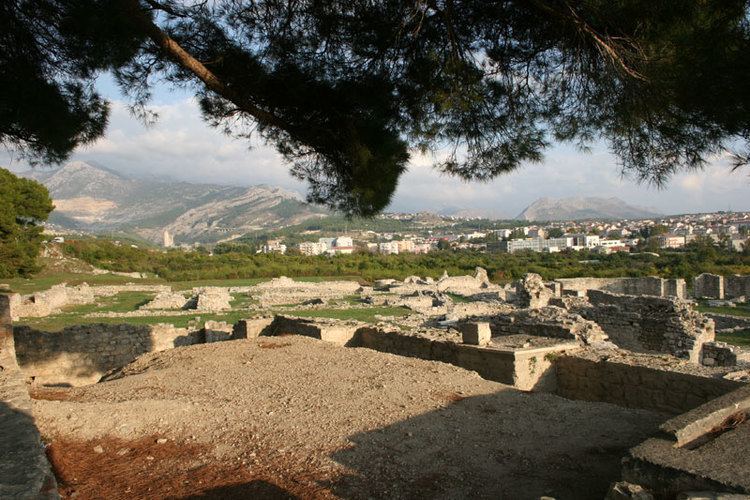
Kolpa otvoritev razstavno prodajnega salona ljubljana btc city
History

In the first millennium BC the Greeks set up an emporion (marketplace) there. After the conquest by the Romans, Salona became the capital of the Roman province of Dalmatia. Colonia Martia Iulia Salona (the full name of the ancient city) was founded probably after the Roman civil wars under Julius Caesar. The early Roman city encompassed the area around the Forum and Theatre, with an entrance, the Porta Caesarea, on the north-east side, The walls were fortified with towers during the reign of Augustus. The early trapezoidal shape of the city was transformed by eastern and western expansion of the city. The city quickly acquired Roman characteristics: walls; a forum; a theatre; an amphitheatre – the most conspicuous above-ground remains today; public baths; and an aqueduct. Many inscriptions in both Latin and Greek have been found both inside the walls and in the cemeteries outside, since Romans forbade burials inside the city boundaries. A number of fine marble sarcophagi from those cemeteries are now in the Archaeological Museum of Split. All this archaeological evidence attests to the city's prosperity and integration into the Roman Empire.

Salona had a mint that was connected with the mint in Sirmium and silver mines in the Dinaric Alps through Via Argentaria. When the Roman Emperor Diocletian retired, he erected a monumental palace nearby. This massive structure, known as Diocletian's Palace, became the core of the modern city of Split.

Salona's continuing prosperity resulted in extensive church building in the fourth and fifth centuries, including an episcopal basilica and a neighboring church and baptistery inside the walls, and several shrines honoring martyrs outside. These have made it a major site for studying the development of Christian sacred architecture.
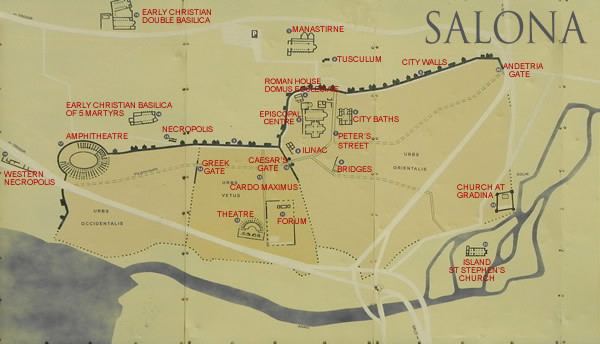
Salona was largely destroyed in the invasions of the Avars and Slavs in the sixth and seventh centuries CE. Refugees from Salona settled inside the remains of Diocletian's Palace.
City walls
The construction of the Salonitan city walls took several centuries. The earliest part of the city was surrounded by walls as early as the second century BC. During the Pax Romana the city expanded to both east and west.
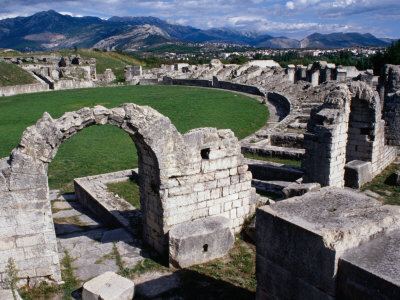
During the reign of Emperor Marcus Aurelius around 170 A.D., under constant threat of Germanic tribes the east and west suburbs were included in the walls which were fortified with at least 90 towers. Some parts of existing buildings were used in the extensions to the walls thus making them an integral part. Total circumference of the elliptical shape of the walls was approximately 4 km, with varying width from 1.9 to 2.5 metres.
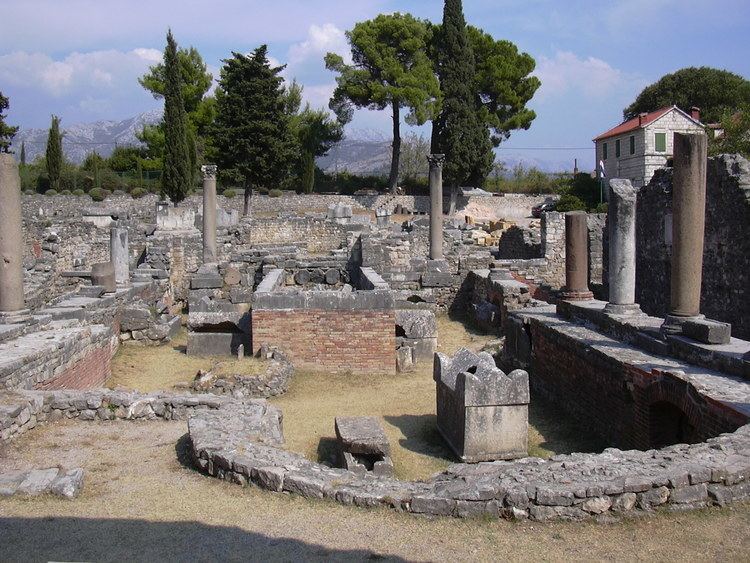
During the reign of Emperor Theodosius II in the early fifth century all the towers were reconstructed, as witnessed by an inscription on the walls. Furthermore, in the first half of the sixth century, in order to improve city's security and defence system, triangular shaped endings were added to some square-shaped towers. Such examples are visible today on the northern side of the Urbs orientalis. Best preserved part of the oldest part of the city (Urbs vetus) is eastern wall and Porta Caesarea with two octagonal towers and tree passages; one for cart traffic and two for pedestrians on each side of the wider passage. Central passage was probably equipped with a movable grid, as indicated by grooves on side pylons. Porta Caesarea was constructed using large regular stones primarily for fortification purposes. After eastern and western expansion had occurred, the gate lost their primary purpose and became carrying construction of the aqueduct. According to Kähler reconstruction, the gate had two floors, of which the top one was very elaborately decorated with half columns, composite capitals, and window openings. Within the gate there was small courtyard for defence purposes.
Thermae
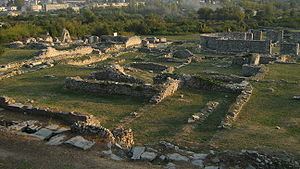
The thermae were typical buildings of Roman civilisation and indispensable part of Roman urban life. Although the city of Salona at the time had multiple baths, best preserved and largest one are those in the eastern part of the city called the Great Thermae, built in the second or beginning of third century A.D. This building is rectangular in shape with three symmetrically arranged apses in the north and one in the west. To the north there was an adjoining elongated spacious room, housing a semicircular pool, the piscina, filled with cold water, the frigidarium. To the left there were two dressing rooms, with benches for sitting and openings in the wall for clothes. The room to the west was also used as a massage room, the unctorium. The room ending with an apse served both as a lounge and an exercise room. To the right there were hot baths and sauna: caldarium, tepidarium and sudatorium.
Bridge of Five Arches
In the eastern suburb of Salona five arches spanned the western-most backwater of the Jadro river (the ancient Salon river). The bridge carried one extension of Decumanus Maximus which branched into two roads, one of which led north-east to the Porta Andetria gate, while the other one led across the bridge to Epetium, today's city of Stobreč.
Amphitheatre
At the westernmost point of Salona, in the Urbs occidentalis, in the second half of the second century A.D. under the influence of Flavian architectural style a monumental building was erected. It is one of the most recognizable buildings of Roman architecture. The remains of Roman amphitheatre indicate that gladiator fights were held in the city of Salona just as in any part of Roman empire, until the fifth century when they were finally banned. The building was ellipsoidal in shape, with three floors on the south side and one floor on the north side, which was conveniently laid down on a natural hillside. Despite its relatively small size (125 by 100 meters outer shell and 65 by 40 meters the arena), Salonitan amphitheatre could have been occupied by 15.000 up to 18.000 spectators. The auditorium was divided into three tires, the lower two with seats and the upper one for standing. In Diocletian's time the top tier was covered with a porch. By means of poles attached to the outer shell of the building the whole arena could be covered with canvas, giving protection from the sun and rain. On the south side there was a state box for the Province governor and opposite it seats of honour for the city magistrates. In the centre of arena there was an opening which led into an underground corridor whose purpose was disposal of dead gladiators' bodies. On the south side of the amphitheatre, beneath the auditorium, there were two vaulted rooms, where gladiators worshipped Nemesis, the goddess of revenge and destiny. During Diocletian's persecutions of Christians, the amphitheatre was used as a site of executions.
Only parts of substructures of this monumental building, as well as some fragments of architectural decoration and stone sculpture have been preserved. The amphitheatre was most severely damaged during the wars against the Turks in the 17th century when Venetians had it demolished for strategic reasons.
